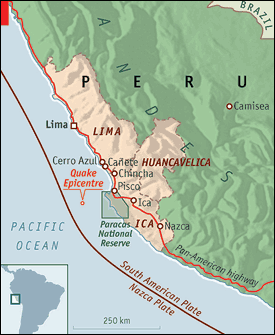After Disaster Struck
August 23, 2007, from The Economist print edition. - Reuters
 (right) A powerful earthquake leaves chaos, homelessness and a daunting task of rebuilding in a once prosperous region
(right) A powerful earthquake leaves chaos, homelessness and a daunting task of rebuilding in a once prosperous region
PISCO, Peru -- ONCE a busy port town of around 60,000 people, Pisco and its narrow streets have been reduced to rubble. Thousands of townspeople nest among the few belongings they were able to save from the wreckage of their homes and lives. Three days after a massive earthquake hit Peru's southern coast on August 15th, the air was still thick with dust.
The earthquake, whose epicentre was close to an active fault line, measured 8.0 on the Richter scale. That was even more powerful than one in 1970 which killed some 70,000 in northern Peru. This time the loss of life was relatively light. When efforts to find survivors stopped, the death toll had reached over 500. More than a thousand were injured.
 But some 100,000 people were made homeless, in what was one of the country's more prosperous and economically dynamic areas. The destruction was almost total in a 150km (95 mile) stretch of Peru's coastal desert south of Lima from the fishing village of Cerro Azul to Ica, a regional capital. In Pisco, all but a handful of buildings either collapsed or were so badly damaged that they must be demolished. Much the same goes for Chincha, a once bustling farming town. Some outlying villages on the slopes of the Andes in the Huancavelica region also suffered.
But some 100,000 people were made homeless, in what was one of the country's more prosperous and economically dynamic areas. The destruction was almost total in a 150km (95 mile) stretch of Peru's coastal desert south of Lima from the fishing village of Cerro Azul to Ica, a regional capital. In Pisco, all but a handful of buildings either collapsed or were so badly damaged that they must be demolished. Much the same goes for Chincha, a once bustling farming town. Some outlying villages on the slopes of the Andes in the Huancavelica region also suffered.
Almost inevitably, the past few days have been marked by chaos and some looting in the worst-affected areas. Gradually, a huge effort by aid agencies moved more than 12,000 tonnes of food, water and supplies to the disaster zone by air and road. Electricity is slowly returning; officials hope water supplies will soon follow.
A daunting task of reconstruction lies ahead. The government has granted $1,900 to each family whose home was destroyed, and money for funeral expenses and for the injured. President Alan García, who spent three days in Pisco directing the aid effort, said that 8,000 local people will be hired for a rebuilding programme for which $95m has been budgeted. That looks far too little: the association of engineers reckons it will cost $600m to rebuild Pisco and Chincha alone.
Besides homes, the government will need to rebuild most schools -- only one of 91 day nurseries in Pisco is still standing -- and some hospitals and prisons. Two prisons collapsed: 600 prisoners escaped from one after the walls fell down. About a third of them gave themselves up over the following week, but the incident added fear of assault and theft to the multiple sufferings of the earthquake's survivors.
Nearly all the homes that collapsed were of adobe, mainly lived in by poorer Peruvians. They were picturesque but lethal. Unless Peru's architects offer swift help, some of its more attractive coastal towns are likely to be reborn as ugly but practical cinder-block affairs.
A first priority is to repair long stretches of the Pan-American highway, Peru's main coastal artery, which collapsed. What is normally a journey of under three hours from Lima to Pisco now takes eight. In 2005 the road's management was turned over to a private consortium which is supposed to invest $275m making it into a motorway from Cerro Azul to Ica in return for toll revenues. Officials were talking to the consortium about emergency repairs.
Fixing the road is crucial to minimising the economic impact of the earthquake. The farms of the Ica region are a centre for Peru's booming exports of asparagus and other crops. Fishing and textile businesses also depend on the highway and the port of Pisco. The government may now expedite plans to privatise the port, to attract the capital needed to rebuild it.
Farmers are losing some $50,000 a day because of transport problems. They could lose export contracts if the road is not back within a month or so. The dozen fishmeal plants in the area face a repair bill of around $30m, reckons Walter Martínez of Hayduk, a fishing company.
Tourism, too, will be curtailed for a while. Several centuries-old haciendas turned into resort hotels have been badly damaged. A natural rock formation, known as the Cathedral, in the Paracas National Reserve, crashed into the sea. Perhaps the only good news was that a plant processing distillates from the Camisea natural-gas field was unscathed, as was a $2.5 billion gas liquefaction terminal being built at Pisco.
According to some forecasts, the disaster could knock as much as a percentage point off economic growth, forecast to be almost 8% this year. Others believe that rebuilding will offset that. The earthquake is a political test for Mr García. He was criticised for not letting local authorities do their job. The government's response to the emergency was less than perfect. But given the difficult circumstances, it has so far not been that bad either.